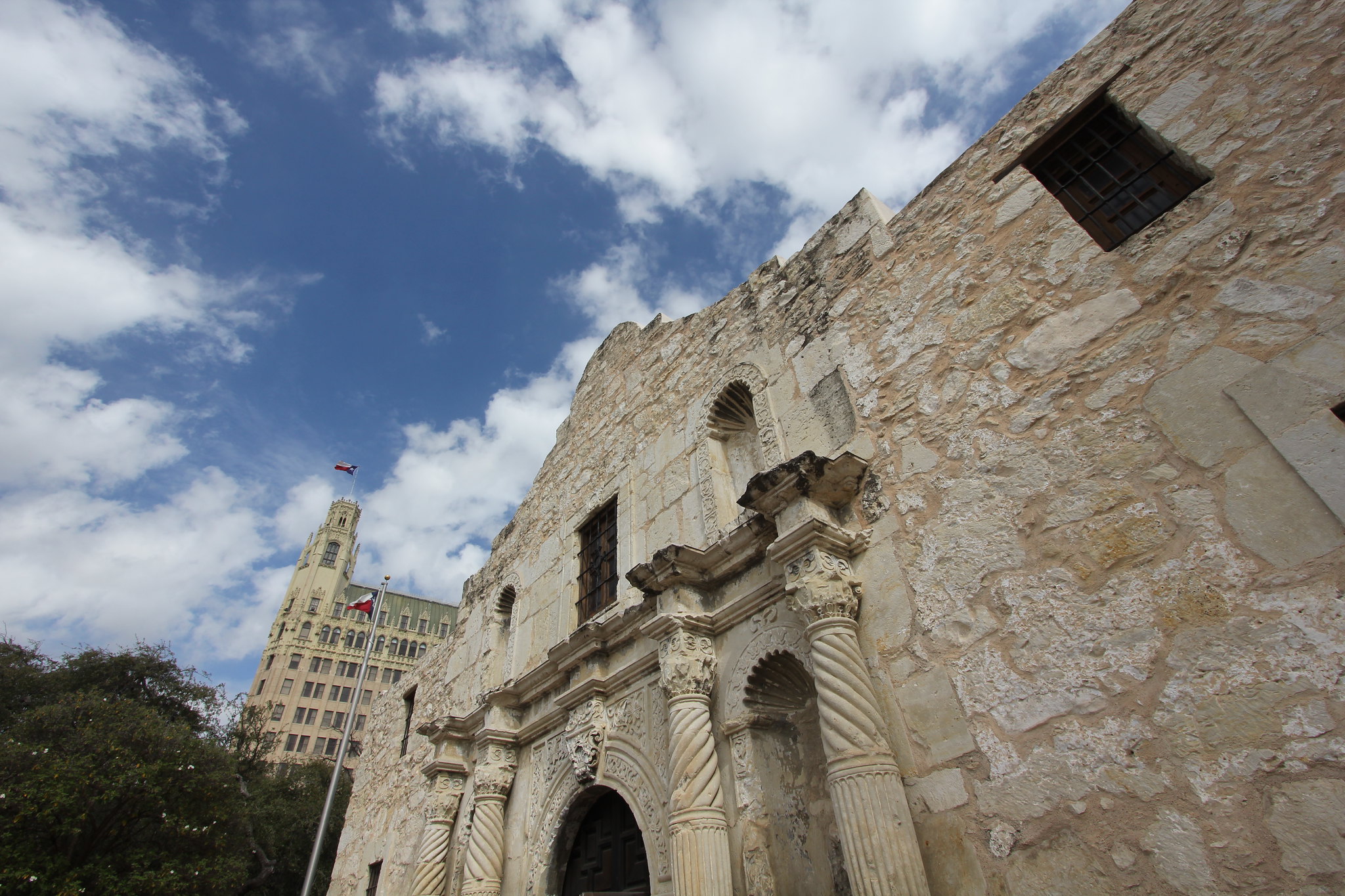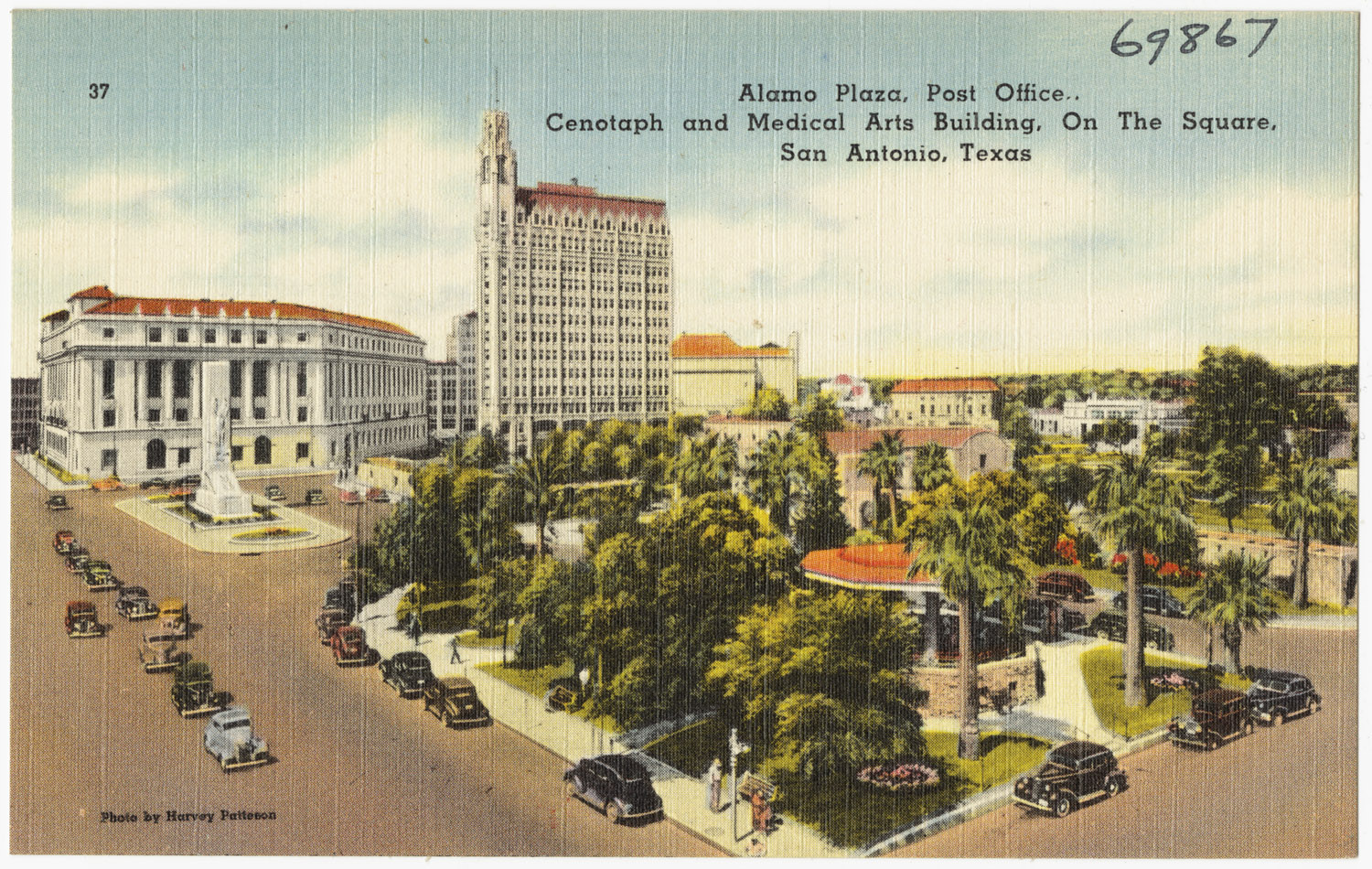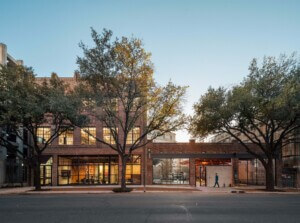The future of the planned redevelopment of Alamo Plaza, a National Register of Historic Places-listed historic district in downtown San Antonio, was thrown into doubt late last month after the Texas Historical Commission struck down a request to relocate the Alamo Cenotaph. The 56-foot tall marble slab monument, located near the front of the fabled 18th-century Franciscan mission, was dedicated in 1940 to commemorate the roughly 200 Texian and Tejano lives lost just over 100 years prior at the Battle of the Alamo.
The request, denied by the Commission with a 12-2 vote, would have entailed moving (and restoring) the deteriorating Alamo Cenotaph from its current site at the northern end of the plaza to a new location just a few hundred feet to the south near the historic Menger Hotel.
As reported by Texas Public Radio (TPR), the Commission’s decision leaves the $450 million redevelopment plan in a state of limbo as major aspects of the project are contingent on the relocation of the cenotaph. The San Antonio City Council originally approved the Alamo Plaza Master Plan in 2018.
In addition to moving the cenotaph, other city-approved elements of the overhaul include closing adjacent streets to traffic to allow for better pedestrian movement, landscaping improvements, establishing an adjacent museum and visitors center, and more. The various tweaks and redesigns are meant to spur economic development in the area while also allowing for a more complete story of the Alamo to be told. This story, as envisioned under the master plan, would extend beyond the battle for Texan independence to also focus on the history of the mission and the Indigenous people of the region.
Following approval from San Antonio City Council, the city’s Historic Design and Review Commission also gave the master plan a proverbial thumbs up late last year, and it had received blessings from both San Antonio Mayor Ron Nirenberg and Land Commissioner George P. Bush.

The Commission’s shock decision was proceeded by the urging of Texas Lieutenant Governor Dan Patrick to leave the cenotaph be—or at least for now. “So, let’s think big, let’s make San Antonio big, let’s do this right, let’s not rush in something today and vote to move the Cenotaph, that’s not what the people of Texas want,” he proclaimed.
This isn’t entirely true. Public opinion about the potential relocation of the cenotaph has been largely divided, as have views about the master plan itself.
“From the beginning the project had both supporters, those who wanted the capital investment in the area and saw see it as a catalyst for greater understanding of the history of the city with economic benefits, and detractors who do not want change, no matter what,” San Antonio-based architect Kevin McClellan explained in an email to AN, stressing the cultural heft that the site holds in the city. Republican lawmakers have been the most vocal of these detractors although some, such as Bush and Congressman Will Hurd, a San Antonio native, have advocated for the cenotaph to be relocated and preserved so that Alamo Plaza can be revived as planned.
As noted by TPR, protective local sentiments regarding the 80-year-old Alamo Cenotaph have only increased in recent months after it was vandalized in late May with anti-white supremacy graffiti. (The monument has been famously defaced by other means in the past.)
“This commission should remain committed and enthusiastic about working alongside the Alamo Trust to create a visitor experience worthy of our state’s most symbolic and indeed revered landmark,” the San Antonio Express-News reported Houston-based Commission chairman John Nau as saying during the hearing. “There is no question that the end result is worth this pain. The end result should be the Cenotaph located where the blood flowed.”
The decision from Nau and his fellow commissioners came as a gut-punch to the city officials, the Texas General Land Office, and the Alamo Trust, the three entities leading the public-private redevelopment of Alamo Plaza. The larger goal of the scheme is to revert the site’s footprint to more closely resemble the way it appeared in 1836 when the battle occurred.
“Our goal has always been to restore the historic 1836 footprint,” Welcome Wilson Jr., chairman of the Alamo Trust, told the commission during the lengthy virtual hearing in September, noting that the Alamo itself, not the cenotaph, serves as the key memorial to the battle. “The Cenotaph was not there in 1836 and the 1836 battlefield had not been reclaimed when they chose to locate in the plaza in 1940,” TPR reported Wilson as saying.
It’s unclear how the Trust will proceed considering that the implementation of the city-approved Alamo Master Plan is, as mentioned, dependent on the relocation of the cenotaph. As the San Antonio Business Journal quoted outgoing Alamo Trust CEO Douglas McDonald in advance of the commission’s project-imperiling vote: “It’s the gate that needs to be opened that allows the project to fully happen.”

A new, reimagined plan in which the Alamo Cenotaph is not relocated would have to be conceived and approved, and that could take time—and there isn’t much time left considering that the idea was to complete the project ahead of the 300th anniversary of the Alamo in 2024. To those involved, going back to square one at this point seems inconceivable.
“With this failing today and the project not being executed the way it was prescribed as city council voted on it in 2018, it puts the whole the whole project in jeopardy,” District 1 Councilman Roberto Treviño, the lead council member involved with the project, said following the vote.
Some, however, view this impasse as a chance to go back to drawing board and wholly rethink the approach outlined in the master plan.
“What this project does well in conceptualizing it gets wrong with its implementation,” McClellan told AN. “The plan seeks to transform the area immediately in front of the Alamo into a large scale reenactment site by reconstructing fortification elements and a delineation of original Mission walls with in-ground markers and glass covered excavations. All-in-all, the project tries to enshrine historical accounts into a public space which sits in the middle of it all. The result is the theming of an urban condition that needs greater care and a better approach. The battle over the relocation of the Cenotaph, which should be moved, ironically may well have stalled a failed project that now may have a fighting chance to be rethought to achieve an inspired resolution, not the presentation of the unreal as real, to solve the problem of identity.”











